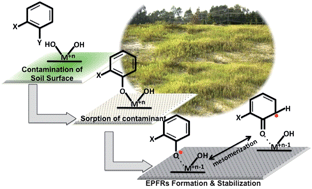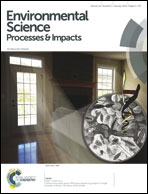Assessment of environmentally persistent free radicals in soils and sediments from three Superfund sites†
Abstract
We previously reported the presence of environmentally persistent free radicals (EPFRs) in pentachlorophenol (PCP) contaminated soils at a closed wood treatment facility site in Georgia. The reported EPFRs were pentachlorophenoxyl radicals formed on soils under ambient conditions via electron transfer from PCP to electron acceptors in the soil. In this study, we present results for soil and sediment samples from additional Superfund sites in Montana and Washington. Paramagnetic centers associated with different chemical environments were characterized by distinct g-factors and line widths (ΔHp-p). EPFR concentrations in contaminated samples were ∼30×, ∼12×, and ∼2× higher than background samples at the Georgia, Montana, and Washington sites, respectively. EPR signals in the Montana contaminated soils were very similar to those previously observed for pentachlorophenol contaminated soils at the Georgia site, i.e., g = 2.00300 and ΔHp-p = 6.0 G, whereas signals in the Washington sediment samples were similar to those previously observed for other PAH contaminated soils, i.e., g = 2.00270 and ΔHp-p = 9.0 G. Total carbon content measurements exhibited direct correlation with EPFR concentration. The presence of radicals in sites contaminated a decade to a century ago suggests continuous formation of EPFRs from molecular contaminants in the soil and sediment.


 Please wait while we load your content...
Please wait while we load your content...